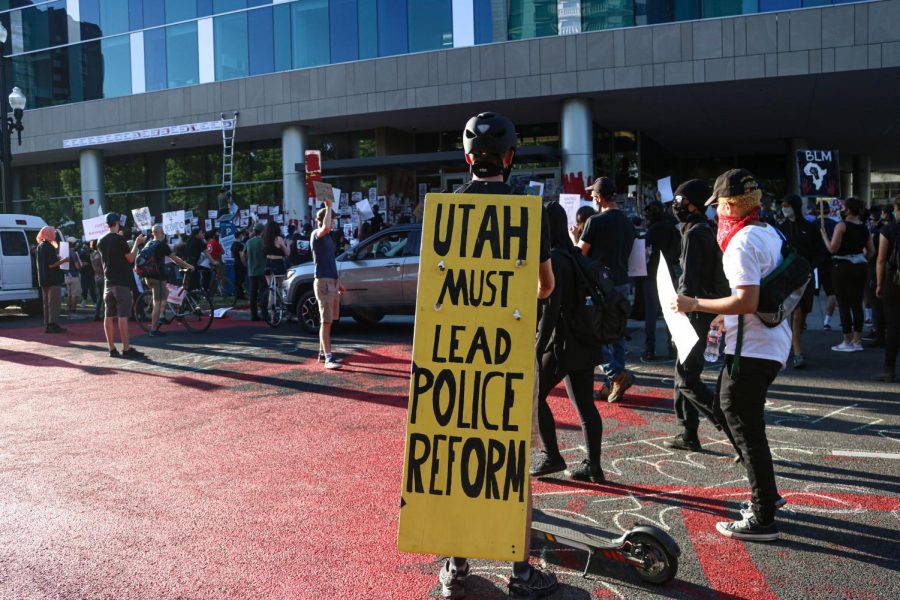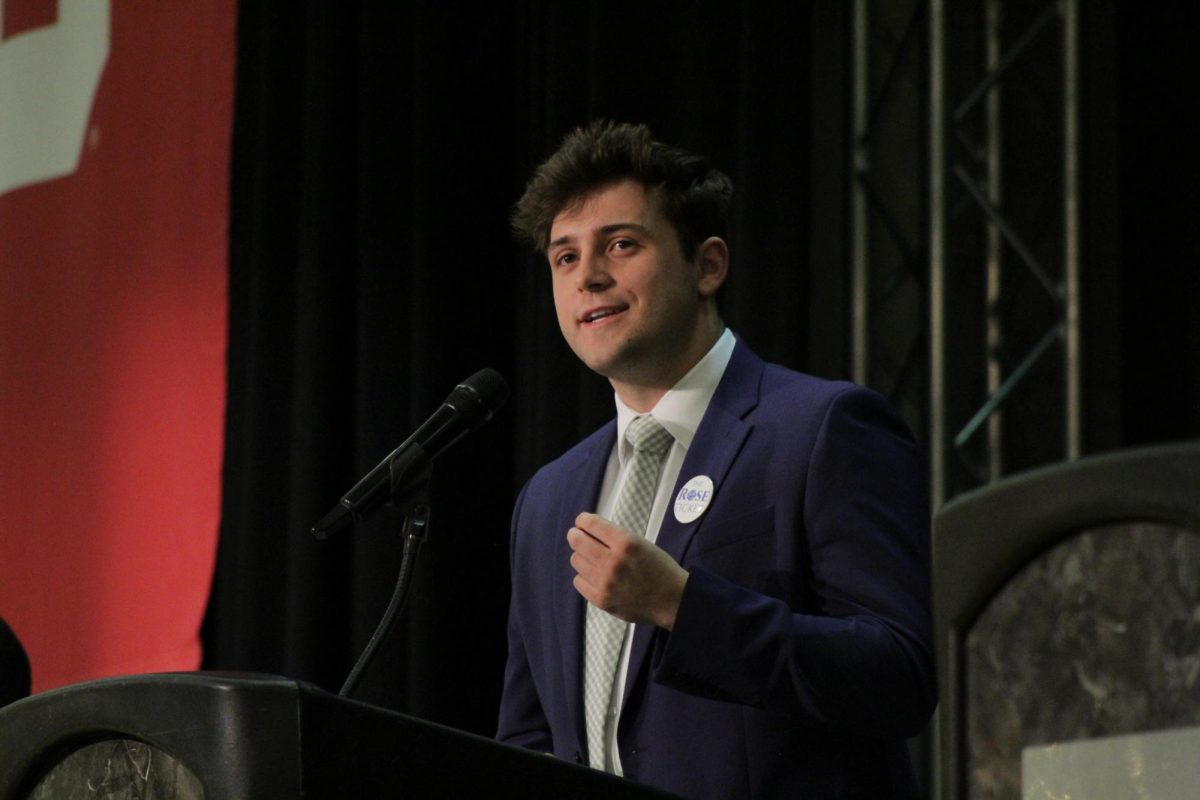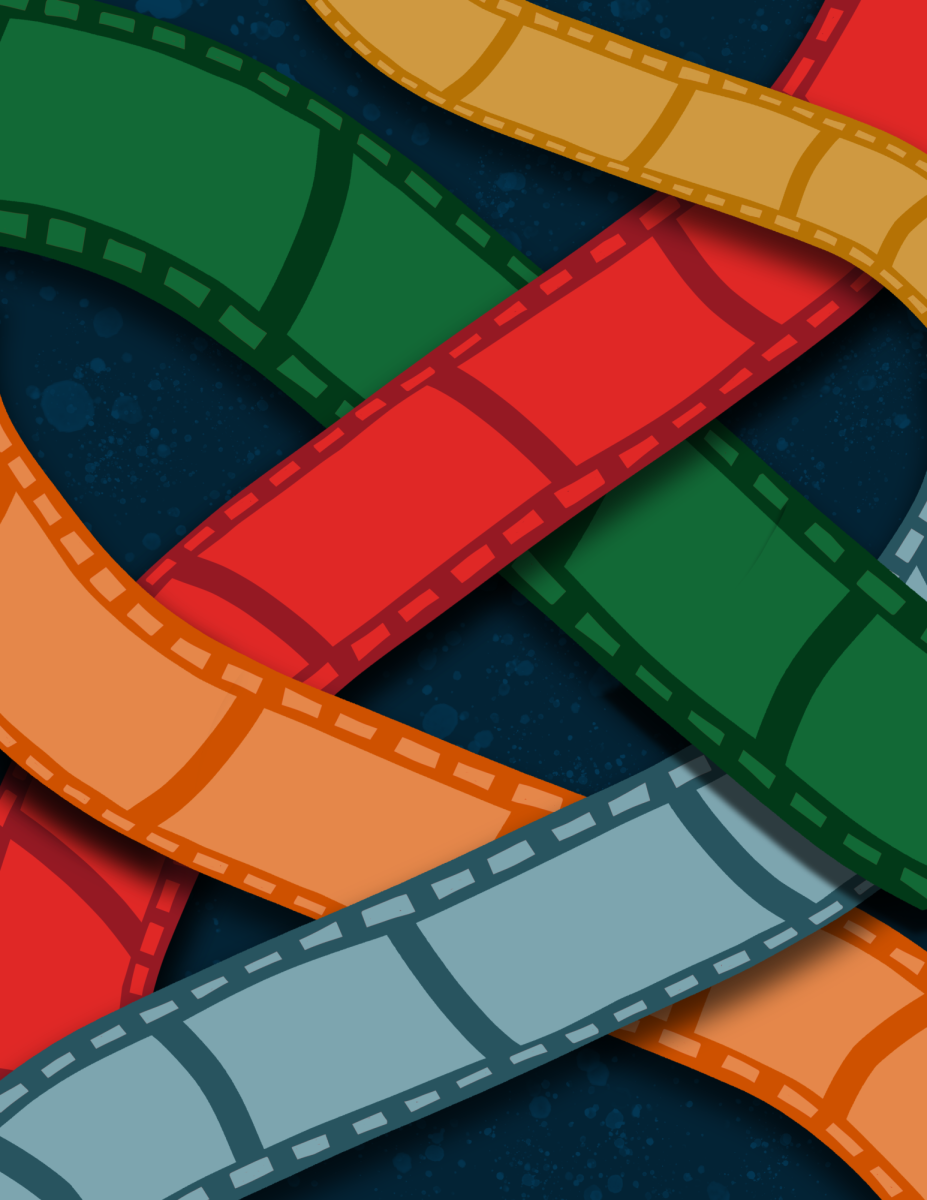Gholami: It’s Time for Restorative Justice in Utah
Protesters paint the district attorney office in Salt Lake City red to illustrate the “blood on Gills hands” after the earlier decision that declared officers involved in the killing of Bernardo Palacios-Carbajal as justified on July 9, 2020. (Photo by Ivana Martinez | Daily Utah Chronicle)
July 25, 2020
The outpour of activism for criminal justice reform has caught the attention of the media in exceptional ways, popularizing different theories on how to best construct a just society. One concept at the forefront of the conversation on reform is the theory of restorative justice. Derived from a variety of “Native American, First Nation Canadian, African, Asian, Celtic, Hebrew, Arab” cultures, the framework of restorative justice is a humane approach toward “resolving conflict and the resulting harm.”
As Vox co-founder Ezra Klein puts it, these two approaches — our current system vs restorative justice theories — answer different questions. Presently, our criminal justice system asks, “what law was broken? Who broke it? And what should the punishment be?” while restorative justice asks, “who was harmed? What do they need? And whose obligation is it to meet those needs?” Utah has made some strides towards changing the structure of their punitive system, but now is the time to start supporting more empathic practices like restorative justice to bring the human element back into communities mediating justice.
The foundational principles of restorative justice are centered on inclusion, accountability and reintegration. The criminal justice model in the US is narrow in scope — it aims to zero in on a crime and prescribe a punishment to balance out the harm done to the community. Conversely, restorative justice is unique as it zooms out from the crime with the intent of contextualizing the harm. This practice looks beyond the immediacy of the harm to instead understand how the individual and the collective have both experienced traumas. It champions a “belief that the path to justice lies in problem solving and healing rather than punitive isolation.” Research shows that restorative justice works. “Victims who experience a restorative justice program express high levels of satisfaction with the process and the outcomes.” For offenders “restorative justice provides a 14% reduction in the frequency of reoffending.”
I have witnessed how Utah local magistrates like Judge Baxter and Judge Landau have interreacted with community members; they bring an element of human empathy back into a merciless system of punishment as we know it to be today. In Salt Lake City’s Justice Court, a new initiative approved by Judge Landau now “allows offenders to help with the community’s COVID-19 response in exchange for their fines.” In 2004, in an effort to decriminalize homelessness, the SLC Homeless Court was established to help transient populations clear misdemeanor charges typically issued as a result of living on the streets. With Judge Baxter presiding, homeless court promotes “community reintegration, [improves] quality of life, self-sufficiency, and access to resources to exit homelessness” for defendants.
The justice reform measures made in Utah are a good first step, but they are slow to be implemented and simply not enough. We need to expand on the energy and empathy that Judges Baxter and Landau have for Utahans and commit to a more comprehensive approach towards restorative justice practices. As the state with the youngest population in the US, Utahns have an important responsibility to ensure that our youth thrive.
In 2016, the Utah Juvenile Justice Working Group was established to make policy recommendations aimed at “improving outcomes for youth.” The findings report that the majority of youth in Utah’s juvenile justice system are entering with “low-level charges, such as truancy and possession of marijuana or drug paraphernalia.” The state has paid up to $127,750 a year per individual in a juvenile facility. Placing them in these systems doesn’t actually help as, “roughly half of juveniles released from probation and out-of-home placement were adjudicated for a new offense or convicted in the adult system within two years.” Not surprisingly, “racial and ethnic disparities in probation and custody dispositions” were apparent and more pronounced the further a youth progressed in the system. Restorative justice practices have proven to save money and reduce reoffending for youth within the juvenile justice system.
Right now, Utah does not have the infrastructure or investment in community efforts to divert youth from entering juvenile detention centers. In order for them to get the punishment our system thinks that these youth ‘deserve,’ we resort to removing them from the community and isolating them in these facilities. Utah judges could place youth into state custody “for nearly any offence, regardless of severity or the youth’s risk level.” Even the director of Juvenile Justice Services has said, “we should not be removing youths from their homes to get the help they need just because services don’t exist in the community. We need to shift system resources to meet the needs of youth while keeping them home when it’s safe to do so.” For a state that cares so much about the lives of children, it is imperative that we start administering restorative justice models for our youth.
Humans are vibrantly flawed and will continue to be so. As we further the conversation on US criminal justice reform, we must reexamine our obsessive desire for offenders to suffer and replace it with an impetus on transformative experiences that allow for community reintegration. Restorative justice aims to repair the harm done for victims while maintaining offender accountability in a way that prioritizes human connection. Our state claims to value children and families and prides itself in community building; we shouldn’t hesitate to apply those same values towards justice-involved individuals.













Zoe Wyse • Jul 26, 2020 at 7:21 pm
I very much agree with you. Restorative justice is the kind of approach that should be much more widely embraced. It is so much more humane. It recognizes the dignity in the other person and treats them with equality, as a fellow human being who has made a mistake, rather than someone to be punished and controlled. There may be situations in which interaction between a victim and the person who has created harm may be less desirable. One example is certain types of domestic violence situations, in which change can often be painfully hard for people who are trying to change these behaviors. But batterer intervention programs can be conducted in a way that is respectful and supportive. There is a beautiful example of this kind of peer led program in “No Visible Bruises” both inside a correctional facility and in the community.
The legacy of structural racism and white supremacy in our country has decimated Black communities, and I recognize that this issue goes beyond the issue of “punishment” versus humane treatment and restoration. This has been an unequal, systemic targeting of Black people through policies that have confined huge swaths of these communities to prison and subsequent disenfranchisement and stigmatization.
But like you, I also hope that this conversation can move into a broader effort not simply to stop targeting Black people, but to treat all people with kindness and humanity. Removing someone from their community for any period of time should be an absolute last resort, if no other process of restorative justice, community treatment, or less intrusive safety measures can reasonably keep other people safe. It should never be the first option. And right now, it is too often the first option.
When people feel strongly that punishment is important and necessary, I cannot help wondering how much they have been punished and hurt themselves. There is sometimes a desire to hold onto ways of thinking that have harmed us, rather than reflecting on how hard it was to be hurt. The book “Why Do They Kill” provides a beautiful example of this. A man who was abused by his father as a child reflected on his abuse stating ‘How else could he have kept me in line?’ adding ‘I really would have been out of a control if he hadn’t have done that.’ Despite this, it is hard to believe that V. could have been more out of control. He admitted that he had begun to drink and to use drugs every day at age twelve. During his teens, V. had been arrested dozens of times for stealing cars, breaking into homes, vandalizing property” (Why Do They Kill, Dave Adams, p. 124).
As humans we sometimes hold onto things that don’t work because it is more painful to recognize that the ways others treated us were damaging and not compassionate. Dr. James Gilligan has also reflected on the way that punishment tends to increase violence, by compounding shame. But many people have themselves been harmed and continue to perpetuate this cycle, partly because of one’s own wounds that cannot be examined. There is an opportunity here for healing oneself as well as extending more mercy, healing and kindness to other people.
I absolutely agree with you that restorative justice is the model that should be overwhelmingly used. No model should include a desire for punishment (basically making someone else suffer). There are situations in which a person may truly be unable or unwilling at a certain point in time to participate in a restorative process in the community. But removing someone from the community should be an absolute last resort and as rare as possible. The fact that Ted Bundy may need to be in a secure setting does not mean that everyone who has committed a murder needs to be. There should be a presumption that restoration in the community is the right approach unless strong, unequivocal evidence points against this because it creates extreme ongoing safety issues for other people that cannot be adequately mitigated in any other way. (There are stories in “No Visible Bruises” and “Why Do They Kill?” that illustrate some of these potential safety issues). We also need to vastly improve our ability to mitigate risk in ways that do not involve incarceration. Right now, we use the reverse process. That needs to change. And the intention of all interactions should be to treat someone humanely and with dignity and equality, not to punish or shame them.